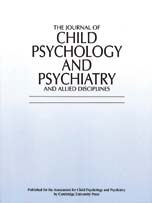Crossref Citations
This article has been cited by the following publications. This list is generated based on data provided by
Crossref.
Leong, Che Kan
Cheng, Pui-Wan
and
Lam, Catherine C. C.
2000.
Exploring reading-spelling connection as locus of dyslexia in Chinese.
Annals of Dyslexia,
Vol. 50,
Issue. 1,
p.
239.
Goswami, Usha
Ziegler, Johannes C.
Dalton, Louise
and
Schneider, Wolfgang
2001.
Pseudohomophone Effects and Phonological Recoding Procedures in Reading Development in English and German.
Journal of Memory and Language,
Vol. 45,
Issue. 4,
p.
648.
Tamaoka, Katsuo
Kirsner, Kim
Yanase, Yushi
Miyaoka, Yayoi
and
Kawakami, Masahiro
2002.
A Web-accessible database of characteristics of the 1,945 basic Japanese kanji.
Behavior Research Methods, Instruments, & Computers,
Vol. 34,
Issue. 2,
p.
260.
Yin, Wen Gang
and
Weekes, Brendan Stuart
2003.
Dyslexia in Chinese: Clues from cognitive neuropsychology.
Annals of Dyslexia,
Vol. 53,
Issue. 1,
p.
255.
Lau, Kit‐ling
and
Chan, David W.
2003.
Reading strategy use and motivation among Chinese good and poor readers in Hong Kong.
Journal of Research in Reading,
Vol. 26,
Issue. 2,
p.
177.
Chen, Xi
Shu, Hua
Wu, Ningning
and
Anderson, Richard C.
2003.
Stages in learning to pronounce Chinese characters.
Psychology in the Schools,
Vol. 40,
Issue. 1,
p.
115.
Ho, Connie Suk-Han
Ng, Ting-Ting
and
Ng, Wing-Kin
2003.
A “Radical” Approach to Reading Development in Chinese: The Role of Semantic Radicals and Phonetic Radicals.
Journal of Literacy Research,
Vol. 35,
Issue. 3,
p.
849.
Shu, Hua
2003.
Chinese writing system and learning to read.
International Journal of Psychology,
Vol. 38,
Issue. 5,
p.
274.
Lau, Dustin Kai-Yan
and
Leung, Man-Tak
2004.
Development of sub-character processing and the use of orthographical and phonological memories in learning new Chinese characters in primary school-aged normal readers.
Asia Pacific Journal of Speech, Language and Hearing,
Vol. 9,
Issue. 1,
p.
54.
Jaffré, Jean-Pierre
2005.
Introduction: The Orthography of French.
L1-Educational Studies in Language and Literature,
Vol. 5,
Issue. 3,
p.
353.
Lau, Kit‐Ling
2006.
Reading strategy use between Chinese good and poor readers: a think‐aloud study.
Journal of Research in Reading,
Vol. 29,
Issue. 4,
p.
383.
Li, Hong
Shu, Hua
McBride-Chang, Catherine
Liu, Hong Yun
and
Xue, Jin
2009.
Paired associate learning in Chinese children with dyslexia.
Journal of Experimental Child Psychology,
Vol. 103,
Issue. 2,
p.
135.
Lau, Kit‐Ling
2009.
Reading motivation, perceptions of reading instruction and reading amount: a comparison of junior and senior secondary students in Hong Kong.
Journal of Research in Reading,
Vol. 32,
Issue. 4,
p.
366.
Wu, Xiaoying
Anderson, Richard C.
Li, Wenling
Wu, Xinchun
Li, Hong
Zhang, Jie
Zheng, Qiu
Zhu, Jin
Shu, Hua
Jiang, Wei
Chen, Xi
Wang, Qiuying
Yin, Li
He, Yeqin
Packard, Jerome
and
Gaffney, Janet S.
2009.
Morphological Awareness and Chinese Children's Literacy Development: An Intervention Study.
Scientific Studies of Reading,
Vol. 13,
Issue. 1,
p.
26.
Wang, Jiu-Ju
Bi, Hong-Yan
Gao, Li-Qun
and
Wydell, Taeko N.
2010.
The visual magnocellular pathway in Chinese-speaking children with developmental dyslexia.
Neuropsychologia,
Vol. 48,
Issue. 12,
p.
3627.
Leong, Che Kan
Loh, Ka Yee
Ki, Wing Wah
and
Tse, Shek Kam
2011.
Enhancing orthographic knowledge helps spelling production in eight-year-old Chinese children at risk for dyslexia.
Annals of Dyslexia,
Vol. 61,
Issue. 1,
p.
136.
Leong, Che Kan
Tse, Shek Kam
Loh, Ka Yee
and
Ki, Wing Wah
2011.
Orthographic Knowledge Important in Comprehending Elementary Chinese Text by Users of Alphasyllabaries.
Reading Psychology,
Vol. 32,
Issue. 3,
p.
237.
Zhang, Yanhui
2011.
Similarity and Degree of Perplexity Analysis of Chinese Characters.
Journal of Quantitative Linguistics,
Vol. 18,
Issue. 3,
p.
189.
Leong, Che Kan
and
Ho, Man Koon
2012.
Training Orthographic and Sentence Structures Helps Poor Readers in Chinese.
International Journal of Disability, Development and Education,
Vol. 59,
Issue. 4,
p.
359.
Ho, Connie Suk-Han
Wong, Yau-Kai
Yeung, Pui-Sze
Chan, David Wai-ock
Chung, Kevin Kien-Hoa
Lo, Sau-Ching
and
Luan, Hui
2012.
The core components of reading instruction in Chinese.
Reading and Writing,
Vol. 25,
Issue. 4,
p.
857.

